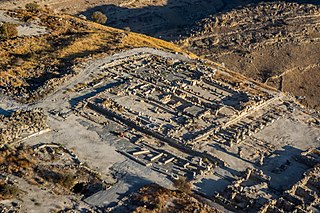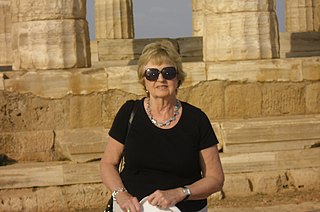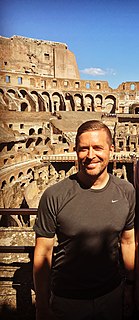
Hippos is an archaeological site in the Israel-Syria DMZ, on a hill in the northern Jordan Valley overlooking the Sea of Galilee. Between the 3rd century BCE and the 8th century CE, Hippos was the site of a Greco-Roman city, which declined towards the end of the Byzantine period and the Ealy Muslim period, and was abandoned after an earthquake in 749. Besides the fortified city itself, Hippos controlled two port facilities on the lake and an area of the surrounding countryside. Hippos was part of the Decapolis, or Ten Cities, a region in Roman Jordan, Syria and Israel that were culturally tied more closely to Greece and Rome than to the Semitic ethnoi around.

Josef Strzygowski was a Polish-Austrian art historian known for his theories promoting influences from the art of the Near East on European art, for example that of Early Christian Armenian architecture on the early Medieval architecture of Europe, outlined in his book, Die Baukunst der Armenier und Europa. He is considered a member of the Vienna School of Art History.
Frank Edward Brown was a preeminent Mediterranean archaeologist.
John Bryan Ward-Perkins, was a British Classical architectural historian and archaeologist, and director of the British School at Rome.

Dame Averil Millicent Cameron, often cited as A. M. Cameron, is a British historian. She was Professor of Late Antique and Byzantine History at the University of Oxford, and the Warden of Keble College, Oxford, between 1994 and 2010.

Géza Alföldy was a Hungarian historian of ancient history.
Ken Dark is a British archaeologist who works on the 1st millennium AD in Europe and the Roman and Byzantine Middle East, on the archaeology of religion, archaeological theory and methods, and on the relationship between the study of the past and contemporary global political, cultural and economic issues. He received a BA in archaeology from the University of York in 1982 and after taking his PhD in archaeology and history at the University of Cambridge taught at the universities of Cambridge, Oxford and Reading. Since 2001 he has been Director of the Research Centre for Late Antique and Byzantine Studies at the University of Reading and, since 1996, Chair of the Late Antiquity Research Group. He holds honorary professorships from several European and American universities, has written numerous books and academic articles and has directed and co-directed many excavations and survey projects, both in Britain and the Middle East including in Istanbul (Turkey) – where since 2004 he has co-directed a new archaeological study of the famous Byzantine church of Hagia Sophia and its environs – and in and around Nazareth (Israel). He is a Fellow of the Society of Antiquaries of London, the Royal Historical Society, and the Royal Anthropological Institute of Great Britain and Ireland, and a member of the Royal Institute of International Affairs - the only person ever elected to all four of these learned societies.
Stefan Lehmann is a German classical archaeologist.
John Richard "Jaś" Elsner, is a British art historian and classicist, who in 2013 was Humfry Payne Senior Research Fellow in Classical Archaeology and Art at the University of Oxford, based at Corpus Christi College, and Visiting Professor of Art History at the University of Chicago. He is mainly known for his work on Roman art, including Late Antiquity and Byzantine art, as well as the historiography of art history, and is a prolific writer on these and other topics. Elsner has been described as "one of the most well-known figures in the field of ancient art history, respected for his notable erudition, extensive range of interests and expertise, his continuing productivity, and above all, for the originality of his mind", and by Shadi Bartsch, a colleague at Chicago, as "the predominant contemporary scholar of the relationship between classical art and ancient subjectivity".
Winfried Orthmann is a German archaeologist specialized on Near East regions.
Ulrich Sinn is a German classical archaeologist.
Ute Verstegen is a German archaeologist. She is a professor for Christian Archaeology and Byzantine Art History at the University of Marburg.
Sabine Renate Huebner/Hübner is Professor of Ancient History at the University of Basel (Switzerland) and Head of Department. She is an expert on the religious and social history of antiquity, particularly of Graeco-Roman Egypt.
Herbert Guido Koch was a German classical archaeologist.
Roland Ralph Redfern "Bert" Smith, is a British classicist, archaeologist, and academic, specialising in the art and visual cultures of the ancient Mediterranean. Since 1995, he has been Lincoln Professor of Classical Archaeology and Art at the University of Oxford.

Julia Hillner is Professor for Dependency and Slavery Studies at the University of Bonn. She was previously Professor of Medieval History at the University of Sheffield. She is an expert on late antiquity, applying digital methods of social network analysis to large data sets drawn from a wide variety of late antique and early medieval sources.
Jennifer Baird, is a British archaeologist and academic. She is Professor in Archaeology at Birkbeck, University of London. Her research focuses on the archaeology of Rome's eastern provinces, particularly the site of Dura-Europos.
Lea Margaret Stirling is a Canadian classical scholar and professor in the Department of Classics at the University of Manitoba. Her research focuses on Roman archaeology and Roman art with particular emphases on Roman sculpture, Late Antique art, and cemetery archaeology, and Roman North Africa.

Sinclair Wynn Bell is an American classical archaeologist and art historian. He is a Professor of Art History at Northern Illinois University where he teaches courses in Greek, Etruscan, and Roman art history, architecture, and archaeology, as well as museum studies. His research focuses on the art and archaeology of the Etruscans; sport and spectacle in the Roman imperial period, especially the Roman circus; and slavery in ancient Rome, especially the visual representation of slaves, freedmen, and foreigners in Roman art.
Ann Mari Yasin is an Associate Professor of Art History and Classics at the University of Southern California specializing in the architecture and material culture of the Roman and late antique world. She studies materiality, built-environments, landscapes, and urbanism as they pertain to the ancient and late ancient religious worlds.





